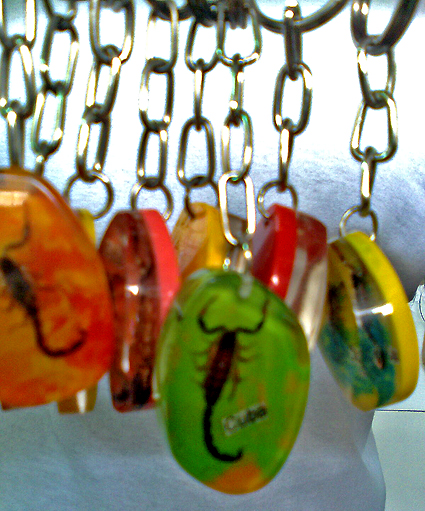Sane Art or Sick Art
Isbel Diaz Torres

Summer has begun, and —as is now the custom in Havana— artisans have taken over the Cuba Pavilion facility on busy 23rd St. What caught my attention this time were some colorful key rings that had inside… scorpions?!
Cuba Pavilion is a large enclosure that is located on one of Havana’s main thoroughfares and where expositions are held throughout almost the entire year. Though I hardly ever buy anything there I like to go to look. In this way, consumer society is teaching us how to be good buyers, preparing for when we will one day have money.
Possessing more or less usefulness, holding more or less beauty, crafted with more or less creativity, the various types of booths are mixed together. At these artisan fairs, they display and sell all type of objects: artistically designed candles, necklaces made with the most “mysterious” materials, jewelry, books, garments, furniture and much more.
This time I concentrated on the topic of materials used by our artisans to make the objects they sell. Proliferating everywhere were small and medium-sized sea snails, coral or jewelry made from them. Since the animals are not visible in these instances, and for the general public these calcareous or pearly structures pass for stones, it is partially understandable that any ethical conflict goes overlooked.
Notwithstanding, that doesn’t justify the producers, who know full where these goods come from.

A similar situation occurs with objects of tortoiseshell, made from the shell of this beautiful marine turtle. This species is the center of intense protection programs led by the Center for Marine Research and the University of Havana. The horns of cattle are also used for similar purposes, because when they’re polished down they take on a stunning appearance.
The new thing is the key rings. To kill a hundred scorpions so that someone can show them off on a key chain is truly revolting. When responding to my questions, the artisans told me that for them this doesn’t constitute an ethical quandary because “there are more important problems these days…”
Undoubtedly they didn’t study the state of the scorpion population before killing them indiscriminately, nor do they know the function of these within an ecosystem… and apparently they haven’t educated themselves so that these are of any interest to them.
When considering whether the dilemma was possibly between supposed conceptual differences between art and handicrafts, I remembered that similar insanity was also committed for supposed artistic purposes. Such was the case of an exhibition of twelve stuffed toads on display in an arts hall of the very same Cuba Pavilion at the beginning of this year.
That argument, therefore, falls flat. Institutions and curators that welcome such practices, as well as the artists and artisans, should be more responsible. Healthy art should be promoted; art that is respectful of our nature – beyond the artists’ “conceptual depths” or the needs of their pockets. It’s not an aesthetic or economic problem, but one of ethics.





